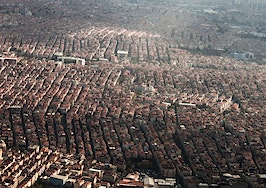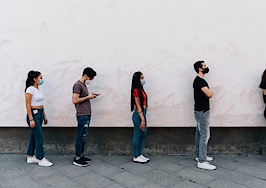Ten months ago, the situation we face now would have seemed unthinkable. Who could have imagined that office workers would need to rebuild their cubicles at home, or that simply going to the store would become an act that requires a mask and hand sanitizer?
The COVID-19 pandemic has utterly redefined how we live, work and interact with our communities. In all likelihood, we’ll probably be dealing with the aftereffects of pandemic-induced societal trauma for years, regardless of how soon a vaccine comes to market.
With that in mind, we have to ask: How will our new quarantine state of mind shape the places in which we seclude ourselves? In a time when at-home havens feel like a necessity, city-based real estate providers have begun to consider how they can craft pandemic-proof — or, at the very least, pandemic-resistant — multifamily living spaces.
The question of pandemic-proofing has circulated through the commercial real estate sector since April, when property owners and institutions began searching for ways to reverse the COVID-prompted professional exodus.
Some ideas have already emerged. In early June, the International WELL Building Institute released a new “Health Safety Rating” allowing building owners to certify that their properties are designed and run to limit infection spread. This new system came to market just weeks after the U.S. Green Building Council announced that it would incorporate new COVID-19 standards into its LEED certifications.
“Special quarantine rooms. Floor-to-ceiling walls in bathroom stalls. Touchless entrances that take your temperature,” Bloomberg journalists described the new measures taken to protect commercial spaces against viral spread. “[Plus] design changes to mitigate airborne spread that might not be easy to incorporate into existing spaces, such as higher ceilings to install air filtration equipment, the avoidance of floor heating systems that can lift aerosols, and the use of rounded corners in crowded spaces, which the standard says minimizes bacterial deposits.”
But how can we adapt these measures to residential spaces? One of the defining draws of city living is the proximity it offers to others, and the access it provides to everyday cultural, artistic, political and social experiences. Amid the pandemic, however, having an isolated, “safe” home to retreat to when necessary may become ever-more important to renters.
“Giving up on urbanity and density is the wrong solution,” building design expert Rami el Samahy told Architectural Digest. “And it is the magic of sports and concerts, at least, to have that common experience. But in all settings, this experience has illustrated that it really is a very tiny world and we are all very connected. We just may have to become a bit less physically so, wherever possible.”
This distanced connectivity may boost the popularity of certain floor plans and designs, even while it rejects others. Michael Liu, the principal for The Architectural Team, recently provided an example of this for Bisnow.
“The open-plan hospitality vibe has been central to marketing to a millennial demographic,” Liu noted. “But in the present pandemic, it may also be ideal for communicating disease.”
So, which design strategies will rise to prominence in a post-pandemic residential market? While the final changes remain to be seen, there are a few clear contenders.
Cleanliness-forward lobbies
While few residents want to live in total sterility, there is something to be said for putting good sanitation practices front and center.
According to recent reporting from Multi-Housing News, many residential building designers have begun considering how they can incorporate hand sanitizer at entrances and install sensor-activated or touchless technology in high-traffic, high-contact spaces such as elevators.
“[These measures] still feel very residential, but at the same time, people have a sense of comfort going into that space,” Rhea Vaflor, director of Lifestyle at Hickok Cole, told MHN. “We’re not living in hospitals.”
Socially distanced amenities
Amenities matter. For many renters, the features a building offers — from gym facilities to on-site classes and pools — may make the difference between signing a lease and choosing another home. However, offering amenities during a pandemic has proved challenging; many buildings shut down their common spaces to prevent the potential spread of COVID-19 among residents.
But closure alone isn’t a permanent solution. Some buildings have used the last several months to rethink the design and provision of their amenity spaces. One Chicago-based residential tower in Chicago told reporters for Bisnow that it redesigned its fitness areas to include “overflow areas” that allow for greater social distancing and scattered sanitizing stations throughout the space.
That said, not all buildings will have the square footage required to follow the Chicago tower’s example and add distancing-friendly “overflow areas” to their indoor amenities. As a result, property owners will likely turn to shared spaces that offer less risk: the outdoors. Given the vastly improved air circulation available outdoors — and the minimized potential for disease spread — it is likely that any residential providers who have the means to offer outdoor activities and amenities will do so.
Of course, virtual amenities are always an option, as well. Some buildings may choose to organize events such as virtual fitness classes, Zoom wine tastings, and other digitally-facilitated attractions.
Private indoor-outdoor spaces
Before the pandemic, FOMO (fear of missing out) was a constant concern. Now, when fear of venturing into public spaces has created an opposite trend: Fear of going out.
As Sheva Rajaee, founder of the Center for Anxiety and OCD in Irvine, California, told reporters for Vox in April, “Some people’s reticence to re-engage with society may resolve on its own but for many, this is the beginning of a lifetime of management.”
Real estate providers can help support their tenants by incorporating indoor/outdoor areas that allow them to socialize and engage with the outdoors while still maintaining a safe distance from others. Structures such as balconies, terraces, porches and yards will likely grow in popularity as people seek more layered home spaces.
“It’s really about having this continuum from very private to very public, but incrementally in between,” architect David Eisen told Multi-Housing News. Tenants want to choose their degree of interaction. By incorporating more indoor-outdoor spaces, residential providers can offer spaces that facilitate post-COVID socialization needs.
The pandemic has tossed our expectations around socialization, work, cleanliness and home into total disarray. Today’s real estate professionals need to take note of tenants’ changing mindsets and develop homes to suit their new needs. COVID-19 has created a new world. Now, we need to learn how to live in it.
Bennat Berger is the cofounder of Novel Property Ventures in New York City. Follow him on LinkedIn and Twitter.





